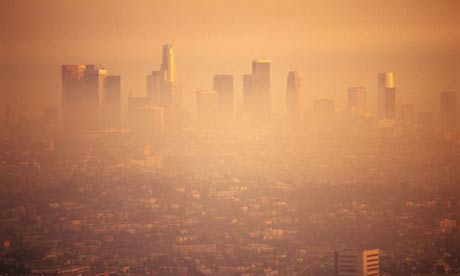
Smog envelopes the skyline of Los Angeles. The EPA has proposed new smog standards. Photograph: Robert Landau/Corbis
The new standard - once eventually approved - would compel state and local authorities to act to reduce smog, which is produced when pollutants from factories, power plants and cars, including ozone and nitrogen oxide, react to sunlight.
The airborne stew has been linked to asthma and other lung diseases, which are especially dangerous to children and the elderly. It also travels hundreds of miles, spreading out from cities and industrial parks to damage wilderness areas.
"Using the best science to strengthen these standards is a long-overdue action that will help millions of Americans breathe easier and live healthier," the head of the Environmental Protection Agency, Lisa Jackson, said in a statement.
"EPA is stepping up to protect Americans from one of the most persistent and widespread pollutants we face."
The proposed new standard would set the acceptable ozone limit in the air at between 0.06 and 0.07 parts per million. That is roughly what scientists recommended. But in early 2008 George Bush personally intervened to override the unanimous opinion of a scientific advisory panel that the EPA needed stronger smog controls. The agency then set the cap at 0.075 parts per million.
Today's proposal would offer significantly stronger protections for human health as well as plants and trees which are damaged by smog, environmental organisations said. Cleaning up smog would also contribute to fighting climate change. A major source of smog are ageing coal power plants, which are also responsible for greenhouse gas emissions.
"This rule will help ensure that all major sources of pollution get cleaned up; it is another indication that the Obama administration sees the big picture and is working hard to put safeguards in place to build the clean energy future," the Sierra Club said in a statement.
The proposal now undergoes 60 days of public comment before becoming final - and oil industry organisations were already mobilising to defeat it today. Once it is enacted, the new regulation - depending on its stringency - will have huge implications for local governments which will be charged with ensuring industry and even motor vehicles come into line.
The EPA estimates the costs of introducing stronger smog controls from $19bn to $90bn a year by 2020, but these would be offset by savings between $13bn and $100bn on healthcare costs each year.
 Obrolan
Obrolan
0 komentar:
Posting Komentar